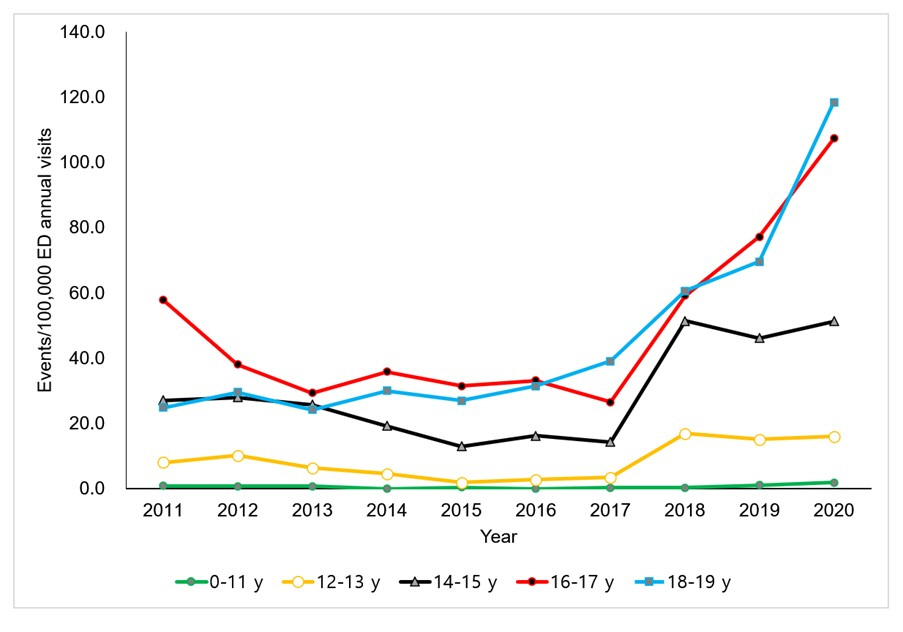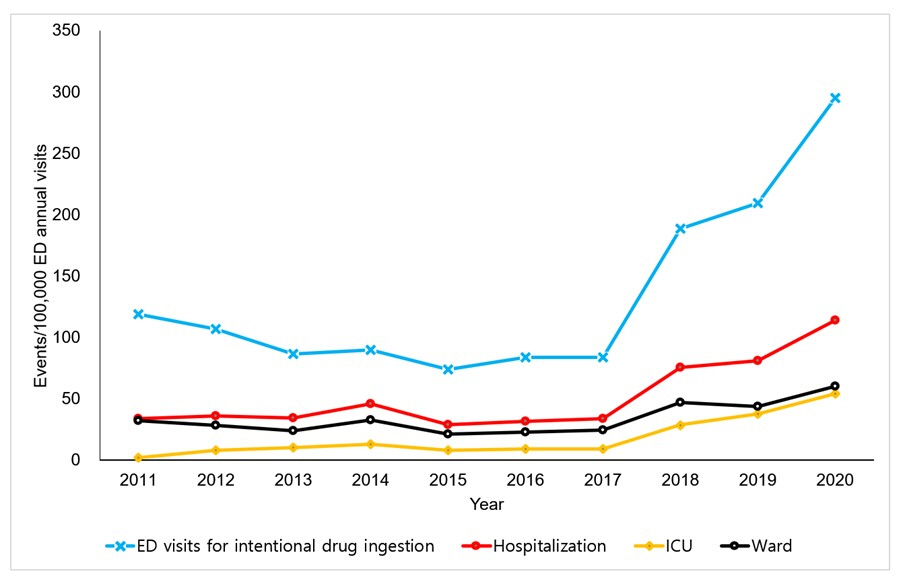Pediatr Emerg Med J.
2023 Oct;10(4):132-141. 10.22470/pemj.2023.00829.
Analysis of 2011-2020 intentional drug poisoning in children and adolescents
- Affiliations
-
- 1Department of Emergency Medicine, Gachon University Gil Medical Center, Gachon University College of Medicine, Incheon, Republic of Korea
- KMID: 2546287
- DOI: http://doi.org/10.22470/pemj.2023.00829
Abstract
- Purpose
We aimed to investigate the changing trends in intentional drug poisoning among pediatric and adolescent patients over the past 10 years.
Methods
A retrospective study was conducted on patients younger than 20 years who visited an academic hospital emergency department (ED) in Incheon, Korea, from January 2011 through December 2020. The study focused on patients who responded with “self-harm or suicide” in the ED-based Injury In-depth Surveillance, and whose injury mechanism was drug poisoning. Exclusion criteria were unintentional injuries and the ingestion of substances other than drugs. To describe the trend over the decade, we used the number of events/100,000 ED annual visits of the database.
Results
A total of 3,388 cases with a median age of 17 years (interquartile range, 15-18 years) were included. The most frequently ingested drugs were acetaminophen (27.8%), followed by benzodiazepines (15.2%), antidepressants (14.1%), other sedatives and hypnotics (13.4%), and antipsychotics (8.3%). As for the events/100,000 ED annual visits, benzodiazepines showed the biggest increase, from 7.6 to 80.2 cases. Similarly, antidepressants increased from 10.2 to 71.1 cases, and antipsychotics from 3.6 to 53.7 cases.
Conclusion
Intentional drug poisoning has increased over the past 10 years, particularly in benzodiazepines, antidepressants, and antipsychotics. It is advisable to establish injury prevention strategies according to patients’ characteristics and ingested drugs.
Keyword
Figure
Reference
-
References
1. Halhalli HC, Uslu T. Evaluation of pediatric patients admitted to the emergency department due to drug intoxication. Cureus. 2021; 13:e13366.2. Korea Infromative Classification of Disesase (KOICD). Korean classification of disease [Internet]. KOICD; 2020 [cited 2023 Jul 31]. Available from: https://www.koicd.kr/kcd/kcd.do?degree=08. Korean.3. Ministry of Health & Welfare, Korea Suicide Prevention Center. White paper on suicide prevention [Internet]. Ministry of Health & Welfare; 2022 [cited 2023 May 5]. Available from: https://www.kfsp.or.kr/web/board/15/276/?pMENU_NO=249&page=2. Korean.4. Lee MH, Jang JH, Cho JS, Choi WS, Choi JY. Clinical features of adolescents with suicide attempt and the factors associated with their outcomes: poisoning versus non-poisoning. Pediatr Emerg Med J. 2020; 7:85–93. Korean.5. Parellada M, Saiz P, Moreno D, Vidal J, Llorente C, Álvarez M, et al. Is attempted suicide different in adolescent and adults? Psychiatry Res. 2008; 157:131–7.6. Tejedor MC, Díaz A, Castillón JJ, Pericay JM. Attempted suicide: repetition and survival--findings of a follow‐up study. Acta Psychiatr Scand. 1999; 100:205–11.7. Scoliers G, Portzky G, Madge N, Hewitt A, Hawton K, De Wilde EJ, et al. Reasons for adolescent deliberate self-harm: a cry of pain and/or a cry for help? Findings from the child and adolescent self-harm in Europe (CASE) study. Soc Psychiatry Psychiatr Epidemiol. 2009; 44:601–7.8. Olfson M, Gameroff MJ, Marcus SC, Greenberg T, Shaffer D. National trends in hospitalization of youth with intentional self-inflicted injuries. Am J Psychiatry. 2005; 162:1328–35.9. Benotsch EG, Koester S, Martin AM, Cejka A, Luckman D, Jeffers AJ. Intentional misuse of over-the-counter medications, mental health, and polysubstance use in young adults. J Community Health. 2014; 39:688–95.10. Griffin E, Corcoran P, Cassidy L, O'Carroll A, Perry IJ, Bonner B. Characteristics of hospital-treated intentional drug overdose in Ireland and Northern Ireland. BMJ Open. 2014; 4:e005557.11. Bachmann CJ, Aagaard L, Burcu M, Glaeske G, Kalverdijk LJ, Petersen I, et al. Trends and patterns of antidepressant use in children and adolescents from five western countries, 2005-2012. Eur Neuropsychopharmacol. 2016; 26:411–9.12. Sheridan DC, Hendrickson RG, Lin AL, Fu R, Horowitz BZ. Adolescent suicidal ingestion: national trends over a decade. J Adolesc Health. 2017; 60:191–5.13. Friedrich JM, Sun C, Geng X, Calello DP, Gillam M, Medeiros KL, et al. Child and adolescent benzodiazepine exposure and overdose in the United States: 16 years of poison center data. Clin Toxicol (Phila). 2020; 58:725–31.14. Sheridan DC, Hendrickson RG, Beauchamp G, Laurie A, Fu R, Horowitz BZ. Adolescent intentional abuse ingestions: overall 10-year trends and regional variation. Pediatr Emerg Care. 2019; 35:176–9.15. Pringle K, Caupp S, Shi J, Wheeler KK, Spiller HA, Casavant MJ, et al. Analysis of intentional drug poisonings using Ohio poison control center data, 2002-2014. Clin Toxicol (Phila). 2017; 55:652–8.16. Sarginson J, Webb RT, Stocks SJ, Esmail A, Garg S, Ashcroft DM. Temporal trends in antidepressant prescribing to children in UK primary care, 2000-2015. J Affect Disord. 2017; 210:312–8.17. Gilley M, Sivilotti MLA, Juurlink DN, Macdonald E, Yao Z, Finkelstein Y. Trends of intentional drug overdose among youth: a population-based cohort study. Clin Toxicol (Phila). 2020; 58:711–5.18. Korea Disease Control and Prevention Agency (KDCA). Emergency Department-based Injury In-depth Surveillance guidebook [Internet]. KDCA; 2023 [cited 2023 Jul 31]. Available from: https://www.kdca.go.kr/injury/biz/injury/recsroom/examinGudbkMain.do. Korean.19. Ha J, Yang HS. The Werther effect of celebrity suicides: evidence from South Korea. PLoS ONE. 2021; 16:e0249896.20. Park J, Jeon W, Ko Y, Choi YJ, Yang H, Lee J. Comparison of the clinical characteristics of pediatric poisoning patients who visited emergency department before and during the COVID-19 pandemic. J Korean Med Sci. 2022; 37:e337.21. Ryu WS, Choi JY, Cho JS, Lim YS, Hyun SY, Yang HJ. Age group characteristics of children who visited the emergency department with acute poisoning by ingestion. Pediatr Emerg Med J. 2018; 5:5–12. Korean.22. Gardner W, Pajer K, Cloutier P, Zemek R, Currie L, Hatcher S, et al. Changing rates of self-harm and mental disorders by sex in youths presenting to Ontario emergency departments: repeated cross-sectional study. Can J Psychiatry. 2019; 64:789–97.23. Howson MA, Yates KM, Hatcher S. Re‐presentation and suicide rates in emergency department patients who self‐harm. Emerg Med Australas. 2008; 20:322–7.24. An YJ, Paek SH, Kim OJ, Kim JA, Kwon JH, Kim MJ. Gender differences in characteristics of adolescents with suicide attempt at the emergency department. Pediatr Emerg Med J. 2020; 7:120–6. Korean.25. Han CS, Jeon WC, Min YG, Choi SC, Lee JS. Retrospective analysis on the clinical differences of children and adolescents treated for acute pediatric poisoning in an emergency department? J Korean Soc Emerg Med. 2013; 24:742–9. Korean.26. Jo SJ, Gang HY, Lee SJ, Bae GH, Lee EJ, Han KS, et al. Continuous control of acetaminophen poisoning after implementation of regulation for ease access of acetaminophen: cohort study from Emergency Department Based In-Depth Injury Surveillance. J Korean Soc Clin Toxicol. 2020; 18:57–65. Korean.27. Hunter K, Poel K, Pennington S, Bindseil I, Banerji S, Leonard J, et al. Trends of prescription psychotropic medication exposures in pediatric patients, 2009-2018. Clin Toxicol. 2022; 60:243–51.28. Lee K, Kim KH, Shin DW, Park J, Kim H, Jeon W, et al. Trends in Korean pediatric poisoning patients: retrospective analysis of national emergency department information system. J Korean Soc Clin Toxicol. 2017; 15:69–78. Korean.29. Bostwick JM, Pabbati C, Geske JR, McKean AJ. Suicide attempt as a risk factor for completed suicide: even more lethal than we knew. Am J Psychiatry. 2016; 173:1094–100.
- Full Text Links
- Actions
-
Cited
- CITED
-
- Close
- Share
- Similar articles
-
- Analysis of Characteristics in Children and Adolescents with Poisoning at Emergency Department
- Analysis of Clinical Characteristics by Gender in Children and Adolescents with Intentional Poisoning at Emergency Department
- Clinical Analysis of Acute Drug Poisoning Victims by Intentional Poisoning
- Clinical features of children with drug poisoning in a single emergency department in Goyang, Korea
- Poisoning in Korean Children and Adolescents





